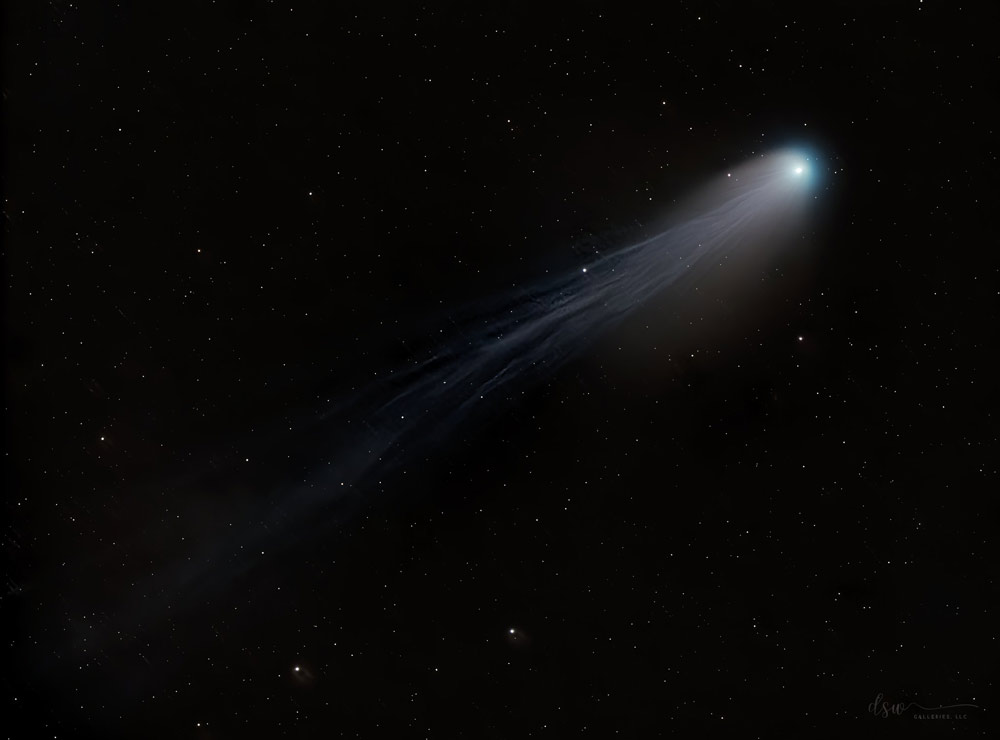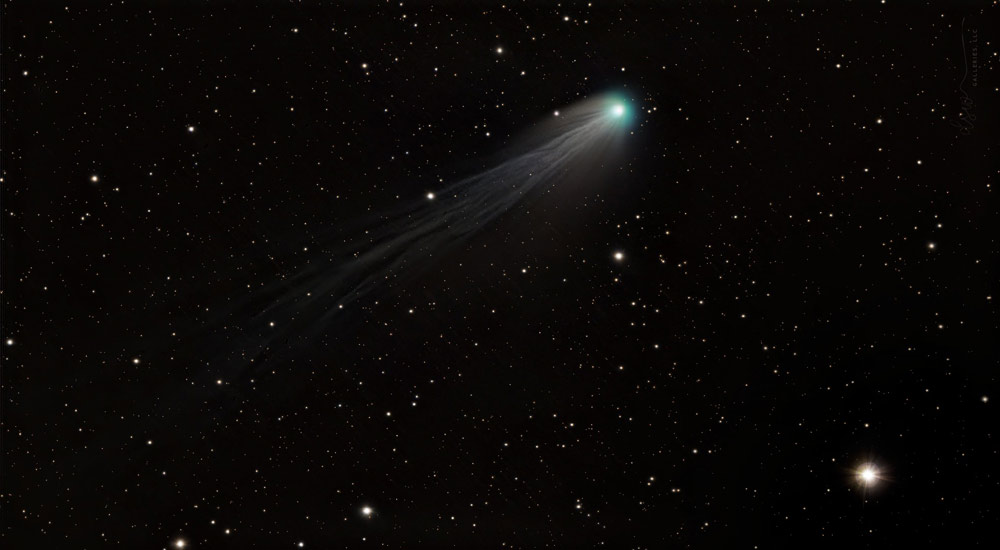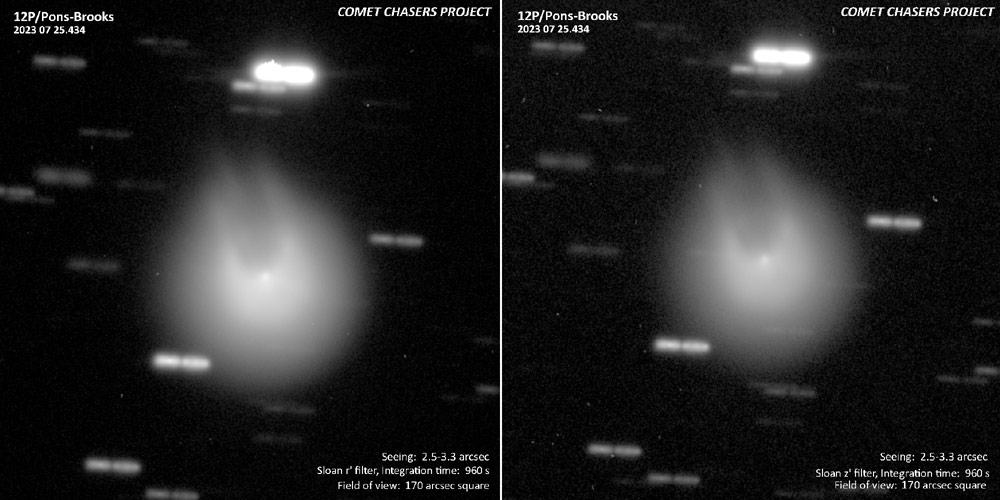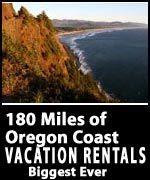Oregon Coast Photog Snags Incredible Images of Comet Above Otter Rock
Published 4/08/24 at 4:55 a.m.
By Oregon Coast Beach Connection staff

(Newport, Oregon) – Last year, Comet 12P / Pons-Brooks caused a stir in the skies when its icy interior was heated by solar radiation, creating a kind of volcanic eruption caused by the chemicals inside the ice. Not only was that discovery remarkable, but the weird shapes it acquired while erupting made for downright outrageous nicknames like the Millennium Falcon Comet or the Devil Comet. (Photo Deep Sky Workflows / Jeremy Likness)
Includes exclusive listings; some specials in winter
In Cannon Beach:
Includes rentals not listed anywhere else
In Manzanita, Wheeler, Rockaway Beach:
Some specials for winter
In Pacific City, Oceanside:
Some specials for winter
In Lincoln City:
Some specials for winter
In Depoe Bay, Gleneden Beach:
Some specials for winter
In Newport:
Look for some specials
In Waldport
Some specials for winter
In Yachats, Florence
Some specials for winter
Southern Oregon Coast Hotels / Lodgings
Reedsport to Brookings, places to stay; winter deals
Now, it appears to be “bursting” again on its 71-year swing through our solar system, and one astrophotographer on the central Oregon coast was adept enough to catch some astounding photographs of the interstellar visitor. Resident Jeremy Likness of Deep Sky Workflows planned ahead for weeks and then caught these images on March 31 in Otter Rock, not far from Newport. [See Bizarre 'Millennium Falcon' / Comet Pons-Brooks in Oregon Coast, Washington Coast Skies]
You could not see it with the naked eye, Likness told Oregon Coast Beach Connection, and that has only rarely happened around the world since it started getting closer. You need some decent optics to spot it, so it's not even like Comet Neowise was a few years back.
“You can make it out as a fuzzy patch with a f/2 or better 50mm+ camera or binoculars. I was in Otter Rock (town) facing Gull Rock in the Pacific,” Likness said.
What are your chances of spotting it?
See the absolute money shot of the bunch where Likness caught the ISS whizzing above Newport and the comet near the Andromeda Galaxy.
Luckily, lately it's been near the horizon of Oregon's sands as well as the Washington coast. You're still going to need optics for this one, however. The human eye alone won't get you there. It's worth that effort, however.
EarthSky.com said Comet Pons-Brooks will be near Jupiter from April 12 through 14, and it's still getting closer to the sun, which could heat it up even more and create more outstanding sights. By late in April, it's going to move out of view of the Northern Hemisphere.
Ironically, it will be at its dimmest when it's at its closest to Earth in early June. By then it will be too far from the sun to pick up much heat and cause the ice and gasses to glow.
How Were the Comet Pons-Brooks Photos Made?

Photo Deep Sky Workflows / Jeremy Likness
The photos were made via some very complex shooting and then processing in the computer, essentially creating a composite. Those starfields and the comet were stacked.
“Comets require a lot of processing because they move at a different rate than stars do, so you're basically chasing two moving targets for the final shot,” he said.
He's also using a telescope and some extremely intricate astrophotography gear to create these.
“I usually use a wide angle, long exposure to get a bunch of light and spot where the comet is, then center it, increase the magnification, and repeat until I'm close to it,” Likness said. “If I'm using my telescope, I have an automated process I run from my laptop to find it for me. ”
Likness delved deeply into how he does all this:
“I brought my gear to a friend's house who has an ocean-facing deck. To ensure my equipment was stable, I used a heavy tripod (35 pounds) with a telescope that weighs 21 pounds. The first step I had to do quickly was to align everything so I could use a motor to move the telescope at the same speed as the stars due to the Earth's rotation so I could take longer exposures. The second step was to get it focused. It took me about one hour to get set up, then I had another hour of shooting before the comet was too low on the horizon. It was a few weeks of planning, two hours in the field, and then another 4 - 5 hours of finding the cleanest shots and processing them for the final result.”
The video also shows a unique set of sides to all this, including a weird pink patch that Likness called an “artifact.” Though it looks like something of The Expanse, it's just a kind of software glitch – but a curious one at that.
“The pink blob was from an issue with the processing software,” Likness said. “The raw photographs are in a format that is too low intensity to see any details with the human eye. It has to be "stretched" or amplified to become visible. To make the video I had hundreds of images, so I ran an automated process to do the stretching. Some of the images get defects - the wind may move the mount while it's exposing creating dancing lights, a bird may fly in front of the lens, a spec of dust can move into the field of view - when this happens, the algorithms that amplify the image get confused and overamplify the defects to create abstract looking blobs.”
Oregon Coast Hotels for this event - South Coast Hotels - Oregon Coast Vacation Rentals - Where to eat - Maps - Virtual Tours
Cannon Beach Lodging
Nehalem Bay Lodgings
Manzanita Hotels, Lodging
Three Capes Lodging
Pacific City Hotels, Lodging
Lincoln City Lodging
Depoe Bay Lodging
Newport Lodging
Waldport Lodging
Yachats Lodging
Oregon Coast Vacation Rentals
Oregon Coast Lodging Specials

Comet Chasers, a team of researchers led by Helen Usher of Cardiff / The Open Universities caught the money shot during the July burst.
More About Oregon Coast hotels, lodging.....
More About Oregon Coast Restaurants, Dining.....
 Andre' GW Hagestedt is editor, owner and primary photographer / videographer of Oregon Coast Beach Connection, an online publication that sees over 1 million pageviews per month. He is also author of several books about the coast.
Andre' GW Hagestedt is editor, owner and primary photographer / videographer of Oregon Coast Beach Connection, an online publication that sees over 1 million pageviews per month. He is also author of several books about the coast.
LATEST Related Oregon Coast Articles
N. Oregon Coast Fave Given All-Clear: City of Cannon Beach Says Gower Access ...Gower St. access / Haystack Rock had signs to keep out of water
If You're Wondering About That Strange, Shredded Plastic-Looking Stuff on Ore...
Glimmering, silvery filaments scattered across the sand. Marine sciences, weather
Surf Advisory for All Oregon / Washington Coast Today, Waves Up To 25 ft - Ea...
So far, king tides doesn't look too dramatic. Weather
First Day Hikes Take Place All Over Oregon and Coast to Start 2026
A special tradition in Yachats, but also Brookings events, Gold Beach events, Port Orford events, Coos Bay events, Bandon events, Florence events, Yachats events, Newport events, Lincoln City events, Rockaway Beach events, Manzanita events, Cannon Beach events, Seaside events, Astoria events
Mussel Gathering Closed Again on S. Oregon Coast After Biotoxins Found
Paralytic shellfish toxin found Cape Blanco to Brookings. Marine sciences
Flooding Shuts Down Roads in Washington, Oregon, Coast
Road issues at Seaside, Neskowin, Hwy 6, SW Washington and more coming. Weather
Old Neskowin in Pictures is Subject of Oregon Coast Event
December 13 in Lincoln City: Neskowin: A Book of Found Photos. Lincoln City events
Lassoing a Wayward Sea Lion Just Part of the Gig for Oregon Coast Deputies
Sea lion wandering near Newport / South Beach streets got some interesting looks. Marine sciences
Back to Oregon Coast
Contact Advertise on Oregon Coast Beach Connection
All Content, unless otherwise attributed, copyright Oregon Coast Beach Connection. Unauthorized use or publication is not permitted



















































